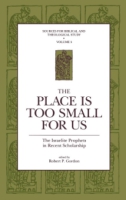
The Place Is Too Small for Us
The Israelite Prophets in Recent Scholarship
Edited by Robert P. Gordon
The Place Is Too Small for Us
The Israelite Prophets in Recent Scholarship
Edited by Robert P. Gordon
These seminal essays have been carefully selected to provide a comprehensive introduction to both the major interpretive issues and the major interpreters of biblical prophetic literature. The essays discuss: The Near Eastern Background; The Message of the Prophets; The Art of Prophecy; Prophecy and Society; The Developing Tradition; Prophecy after the Prophets; and Future Directions.
- Description
- Table of Contents
Series Preface
Editor’s Preface
Abbreviations
Introduction
Robert P. Gordon - A Story of Two Paradigm Shifts
Part 1: The Near Eastern Background
Introduction
Moshe Weinfeld - Ancient Near Eastern Patterns in Prophetic Literature
Abraham Malamat - Prophecy at Mari
Part 2: The Message of the Prophets
Introduction
John Barton - Ethics in Isaiah of Jerusalem
C. Westermann - Oracles of Salvation
Part 3: The Art of Prophecy
Introduction
W. David Stacey - The Function of Prophetic Drama
Walter Houston - What Did the Prophets Think They Were Doing? Speech Acts and Prophetic Discourse in the Old Testament
Stephen A. Geller - Were the Prophets Poets?
D. J. A. Clines - Language as Event
Michael V. Fox - The Rhetoric of Ezekiel’s Vision of the Valley of the Bones
Carol A. Newsom - A Maker of Metaphors: Ezekiel’s Oracles against Tyre
John T. Willis - Dialogue between Prophet and Audience as a Rhetorical Device in the Book of Jeremiah
Michael Fishbane - The Priestly Blessing and Its Aggadic Reuse
John Day - Inner-biblical Interpretation in the Prophets
J. H. Eaton - Festal Drama
P. R. House - Dialogue in Zephaniah
David F. Payne - Jonah from the Perspective of Its Audience
Part 4: Prophecy and Society
Introduction
David L. Petersen - Ecstasy and Role Enactment
A. Graeme Auld - Prophets through the Looking Glass: Between Writings and Moses
Burke O. Long - Social Dimensions of Prophetic Conflict
R. R. Wilson - Interpreting Israel’s Religion: An Anthropological Perspective on the Problem of False Prophecy
Ernest W. Nicholson - Prophecy and Covenant
Thomas W. Overholt - Prophecy in History: The Social Reality of Intermediation
R. P. Carroll - Ancient Israelite Prophecy and Dissonance Theory
Joseph Blenkinsopp - The ‘Servants of the Lord’ in Third Isaiah: Profile of a Pietistic Group in the Persian Epoch
Part 5: The Developing Tradition
Introduction
Walther Zimmerli - From Prophetic Word to Prophetic Book
Ronald E. Clements - Prophets, Editors, and Tradition
H. G. M. Williamson - The Prophet and the Plumb-Line: A Redaction-Critical Study of Amos 7
P. R. Ackroyd - Isaiah 36-39: Structure and Function
Otto Kaiser - Literary Criticism and Tendez-Criticism: Methodological Reflections on the Exegesis of Isaiah
Brevard S. Childs - The Canonical Shape of the Prophetic Literature
Part 6: Prophecy after the Prophets
Introduction
Thomas W. Overholt - The End of Prophecy: No Players without a Program
F. F. Bruce - Prophetic Interpretation in the Septuagint
Christopher T. Begg - The ‘Classical Prophets’ in Josephus’ Antiquities
John F. A. Sawyer - Prophecy and Interpretation
Part 7: Future Directions
Werner H. Schmidt - Contemporary Issues
Ferdinand E. Deist - The Prophets: Are We Heading for a Paradigm Switch?
Robert P. Gordon - Present Trends and Future Directions
Indexes
Index of Authorities
Index of Scripture
Mailing List
Subscribe to our mailing list and be notified about new titles, journals and catalogs.



